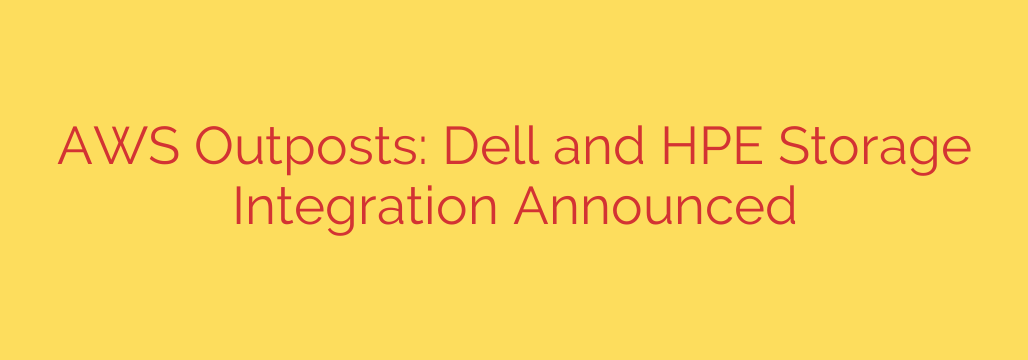
Unlocking True Hybrid Cloud: AWS Outposts Now Integrates with Dell and HPE Storage
For years, enterprises have navigated the complexities of hybrid cloud, seeking a seamless blend of public cloud agility and on-premises control. AWS Outposts has been a cornerstone of this strategy, bringing native AWS services and infrastructure directly into private data centers. However, one significant challenge remained: integrating existing, high-performance on-premises storage. A groundbreaking development has now addressed this head-on, fundamentally changing the landscape for hybrid cloud architecture.
AWS has officially announced support for external storage integrations with AWS Outposts, specifically validating solutions from enterprise giants Dell and HPE. This move allows organizations to connect their trusted, on-premises storage arrays directly to Outposts racks, creating a powerful, unified, and efficient hybrid environment.
The Challenge: Bridging the Storage Gap
AWS Outposts provides local AWS Elastic Block Store (EBS) volumes, which are excellent for many workloads. However, large enterprises have often invested millions in sophisticated on-premises storage systems from providers like Dell and HPE. These systems are fine-tuned for specific, demanding applications requiring ultra-low latency, massive throughput, and advanced data services that generic block storage might not offer.
Until now, using this existing storage with AWS services running on Outposts was a complex, often unsupported process. This created a frustrating silo: powerful AWS compute sat in the data center, physically close but logically distant from the enterprise’s primary data stores. This new validation erases that boundary.
Why This Integration is a Game-Changer for Your Business
This isn’t merely a technical update; it’s a strategic enabler that unlocks significant business value. By bridging the gap between AWS Outposts and on-premise SAN, organizations can now realize several key benefits.
- Leverage Existing Investments: You no longer need to rip and replace your existing storage infrastructure. Protect your significant investments in Dell or HPE storage arrays while modernizing your applications with AWS services. Your teams can continue using the tools and expertise they already possess to manage storage.
- Achieve Unprecedented Performance: Many on-premises workloads, such as large-scale databases (Oracle, SQL Server), SAP HANA, or high-performance computing (HPC) applications, demand sub-millisecond latency. By connecting high-performance Dell PowerStore, PowerMax, or HPE Alletra arrays directly to Outposts, you can run these latency-sensitive applications on AWS infrastructure without compromising on performance.
- Solve for Data Gravity and Sovereignty: Moving petabytes of data to the cloud is slow, expensive, and often impossible due to regulatory and data governance requirements. This integration directly addresses “data gravity.” Keep your data securely on your own storage hardware, within your own data center, while processing it with agile AWS services. This is crucial for industries like finance, healthcare, and government that face strict data residency rules.
- Simplify Data Migration and Management: This new capability provides a smoother on-ramp to the cloud. You can begin migrating applications to run on AWS services via Outposts without first having to migrate the underlying data. This phased approach reduces risk, complexity, and downtime, allowing for a more measured and strategic modernization journey.
Validated Solutions: What’s Supported?
AWS has worked directly with both Dell and HPE to test and validate specific storage platforms, ensuring reliability and performance. This means you can confidently deploy these configurations with full support.
- For Dell Users: The integration supports leading platforms in the Dell portfolio, including Dell PowerStore, PowerMax, and PowerFlex. These systems are known for their high performance, reliability, and advanced data reduction capabilities.
- For HPE Users: The validation extends to HPE Alletra 9000, 6000, and Primera storage systems. These solutions are engineered for mission-critical applications, delivering exceptional speed and resiliency.
The connection is made through AWS Direct Connect, which provides a private, high-bandwidth, and low-latency link between your storage network and your Outposts rack, ensuring data moves quickly and securely.
Actionable Security and Implementation Tips
As you explore this powerful new architecture, it’s vital to proceed with a clear plan. Here are some key considerations for a successful implementation:
- Assess Your Network Foundation: The link between your storage array and the AWS Outposts rack is critical. Ensure you have a robust, low-latency network infrastructure in place. Work with your networking team to guarantee the necessary bandwidth and resiliency to prevent performance bottlenecks.
- Review Your Security Posture: While the data remains on-premises, it is now being accessed by cloud services. Re-evaluate your security policies and access controls. Implement strong authentication and encryption for data-in-transit between the storage array and Outposts, even within your data center. Remember the shared responsibility model still applies.
- Plan for Data Protection: Your existing backup, recovery, and disaster recovery strategies for your on-premises storage must be updated. Consider how you will back up the entire hybrid application stack. This may involve a combination of on-premises snapshot technologies and cloud-based services like AWS Backup or Amazon S3.
- Start with the Right Workloads: Not every application requires this level of integration. Identify the specific workloads that will benefit most—typically those constrained by data gravity, low-latency requirements, or data sovereignty mandates. A targeted, phased rollout is more effective than a broad, all-at-once approach.
The Future is Truly Hybrid
The validation of Dell and HPE storage with AWS Outposts marks a pivotal moment in the evolution of hybrid cloud. It acknowledges that the future of enterprise IT is not a binary choice between on-premises and public cloud, but a seamless integration of both. By allowing organizations to combine best-in-class cloud services with best-in-class enterprise storage, AWS is delivering a more practical, powerful, and cost-effective vision for the modern data center.
Source: https://aws.amazon.com/blogs/aws/announcing-aws-outposts-third-party-storage-integration-with-dell-and-hpe/








